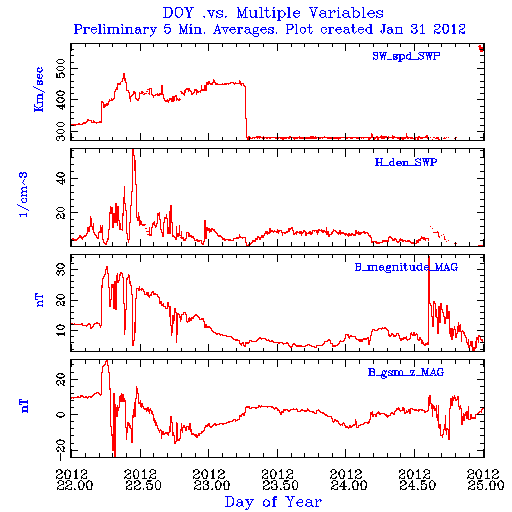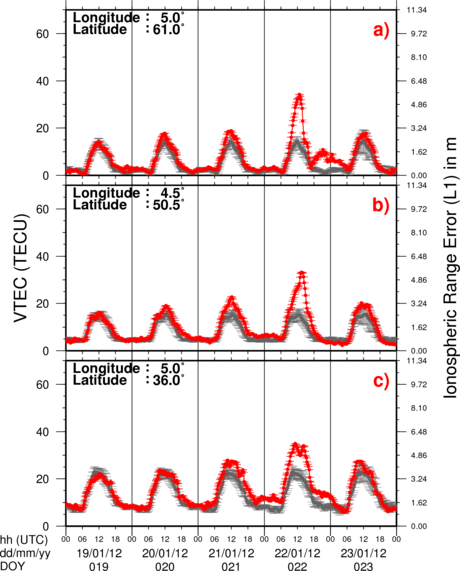The GNSS research group of the Solar-Terrestrial Centre of Excellence measured ionospheric disturbances on Jan 22 which impact the communication and satellite navigation at that moment.
The Jan 22 event versus THE Jan 24 event
On Jan 22, a plasma cloud that travelled from the Sun to the Earth, bumped into the Earth magnetosphere. The plasma was ejected on the Sun on Jan 18-19. The deformation of the Earth magnetic shield was strong enough to cause changes in the ionosphere, a layer of our atmosphere. These changes can disturb radio communication and satellite navigation.
In particular, the Global Navigation Satellite System or GNSS research group of the Solar-Terrestrial Centre of excellence noticed that the Total Electron Content, TEC changed considerably due to the arrival of the cloud. The American GPS and the European Galileo make part of GNSS. The TEC is a measure for the total number of electrons present in a cylindrical volume of 1m2 cross section, straight through the ionosphere. The TEC determines how signals pass through the ionosphere. On Jan 22, the communication and satellite navigation was vulnerable due to the arrival of a solar plasma cloud.
On Jan 23, a relative strong flare occurred, a plasma cloud was ejected and not long after these events, a stream of protons passed several satellites and finally hit the Earth. The solar wind speed measurements done by the satellite ACE were interrupted because of this proton storm as you can see in the top panel of the picture. The bulk of the plasma cloud did not hit the Earth, it was only a glancing blow. The GNSS research group did not notice any disturbances at the time of arrival. On Jan 24, the communication and satellite navigation was not disturbed because of to the glancing blow of the Jan 23 solar plasma cloud.
Check it out on the GNSS website.
The GNSS group observes the ionosphere in near-real time. The result is shown in a map .
More
The ionosphere is a peel around the Earth making part of our atmosphere. The ionosphere is the key layer for communication. For satellite navigation, a signal passes through the ionosphere. For other purposes like long distance radio communication, the ionosphere is used as a mirror to reflect radio signals such that these signals can bounce back to a receiver. It's clear that if the ionosphere is disturbed and changes features, navigation and radio communication can be in trouble. Space Weather can alter the features of the ionosphere.
The ionosphere is formed by the UV and X-ray solar radiation - the sort of radiation that travels with the speed of light and that doesn't need a medium to propagate. If the intensity and the strength of that radiation suddenly changes, the ionosphere and its properties also change. A sudden and intense brightning on the sun, a flare, can introduce ionospheric irregularities on the day side of the Earth.
When a plasma cloud hits the Earth's magnetosphere, our magnetic shield, it causes a geomagnetic storm. Such a storm on its turn can also drive the ionosphere away from its more regular state. A geomagnetic storm can pass along the day side, but also on the night side. A geomagnetic storm is generally linked with latitude: closer to a pole of the Earth, the stronger a geomagnetic storm can be.
For comparison: the magnetosphere extends up to 20 - 25 Earth radii (= 6353 km) on the day-side, i.e. around 130 000 - 160 000 km, while the atmosphere is a layer of 100 km.







